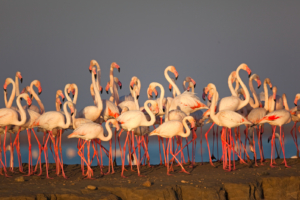This paper was published in the ‘Ecology and Evolution’ journal. The study, to which the Tour du Valat contributed, explains that direct solar radiation rapidly dulls the pink coloration of flamingo feathers. It also helps to better understand the role of applying ‘makeup’ in the maintenance of the color in these species.
You can access to it on the Tour du Valat web documentary portal [1].

Abstract:
Greater flamingos use cosmetic coloration by spreading uropygial secretions pigmented with carotenoids over their feathers, which makes the plumage redder. Because flamingos inhabit open environments that receive direct solar radiation during daytime, and carotenoids bleach when exposed to solar radiation, we expected that the plumage color would fade if there is no maintenance for cosmetic purposes. Here, we show that the concentrations of pigments inside feathers and on the surface of feathers were correlated, as well as that there was a correlation between the concentrations of pigments in the uropygial secretions and on the surface of feathers. There was fading in color (becoming less red) in feathers that received direct solar radiation when there was no plumage maintenance, but not so in others maintained in darkness. When we controlled for the initial color of feathers, the feathers of those individuals with higher concentration of pigments on the feather surfaces were those that lost less coloration after experimental exposure of feathers to sunny conditions. These results indicate that exposure to sunlight is correlated with the fading of feather color, which suggests that individuals need to regularly apply makeup to be more colorful. These results also reinforce the view that these birds use cosmetic coloration as a signal amplifier of plumage color. This may be important in species using highly variable habitats, such as wetlands, since the conditions experienced when molting may differ from those when the signal should be functional, usually months after molting.
Bibliographical reference:
Chiale, M. C., Rendón, M. A., Labaude, S., Deville, A.-S., Garrido-Fernández, J., Pérez- Gálvez, A., Garrido, A., Rendón-Martos, M., Béchet, A., & Amat, J. A. (2021). The color of greater flamingo feathers fades when no cosmetics are applied. Ecology and Evolution, 11, 13773–13779. https://doi.org/10.1002/ece3.8041 [2]